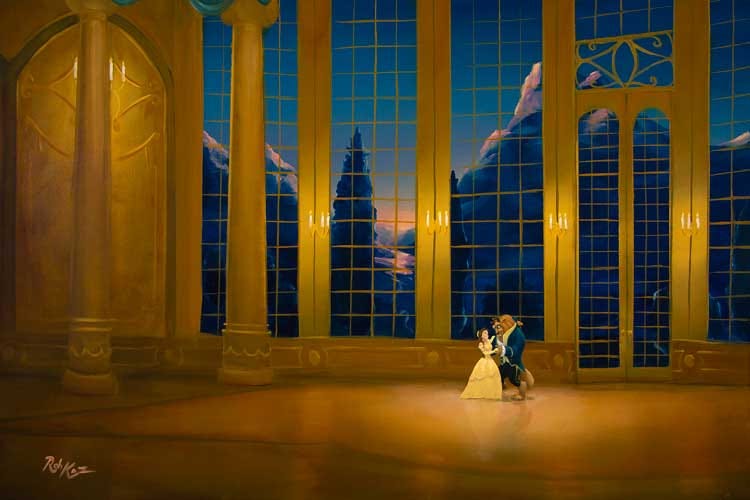
True As It Can Be by artist Rob Kaz, limited edition of 95, sold out
“How can I be a Disney artist?” Because this is the number one question I get asked most often, I decided to make the answer the topic of my first blog story.
You love Disney. You have your entire life. You draw Mickey Mouse like a champ and everyone says you should work for Disney. You just need someone to tell you how.
If you want to work for Disney in animation, then go to school, apply for jobs and eventually work your way into the role you want within the company. Though the answer is straightforward, the path is not without challenges and there is no guarantee you’ll land that dream job. Those folks who make the films … they’re masters of their craft. They’ve worked long, hard hours and are 100% deserving of the credit they receive. For that reason, I remain and watch the rolling credits at the end of a film in the theater. Try it sometime, read the names and show respect to those who made the film you just enjoyed.
If you’re wondering about how to be a self-employed artist who has license to paint Disney art (like me), the answer is not simple or straightforward.
There is no application to submit. There is no phone number to call. No audition to attend. No prerequisite classes to complete. And even more importantly, there are no two stories alike.
All artists who are licensed to paint Disney will have their own stories about how they came to be licensed. First, allow me to share my own story and then I’ll impart advice for those seeking to land their dream job of painting Disney characters for a living.
MY STORY
Upon graduation from University of Central Florida (Go Knights!) with my shiny new Criminal Justice degree, I was convinced I’d immediately land a job in federal law enforcement since I’d successfully completed an internship with the U.S. Postal Inspection Service. On the day my “sorry, but we’re on a hiring freeze” letter arrived, the owner of a small animation studio coincidently saw my art hanging in my parents’ home while he was being given a tour (their home was on the market for sale). He hired me on the spot.
Until that moment, art had been nothing more than a hobby. Going forward, however, art would become my passion.
My time at the small studio was short-lived. I found myself at another studio and then another. I’m not sure what the success-rate stats are for small studios, but in Central Florida I can attest to how difficult it is for studios to stay afloat. Still, those years were invaluable for me. I worked alongside former Disney animators who didn’t move West when Disney closed their Florida-based animation studios. Their talent, their skill … the most amazing artists, visionaries, storytellers … I mean, wow.
Wanting to continue in art when yet another small studio closed its doors, but being apprehensive about committing to yet another, I sought a larger opportunity that I felt might be more stable. I landed a job at EA Tiburon (Electronic Arts) as a character artist creating human likenesses for games including NCAA Football and Madden. The job was amazing. Let’s just be honest for a second — if you know these games, then you know how fulfilling it is to say you’re part of the team contributing to the game.

Pen Sketches on lined notebook paper by artist Rob Kaz
During down times, when I had to wait for certain elements of the game to run their course before I could continue, I sketched. I sketched places I’d rather be. I sketched surf shacks, streams in forests, romanticized tree houses and even dreamed up a small brick gallery called Rob’s. Before long, my cube was covered with pen sketches on lined notebook pages. And though I sketched in black and white, my mind’s eye saw the works in color. My love of fine art (something that had been a hobby which landed me my first studio job) was returning. After work at EA, I turned several of those sketches into oil paintings.
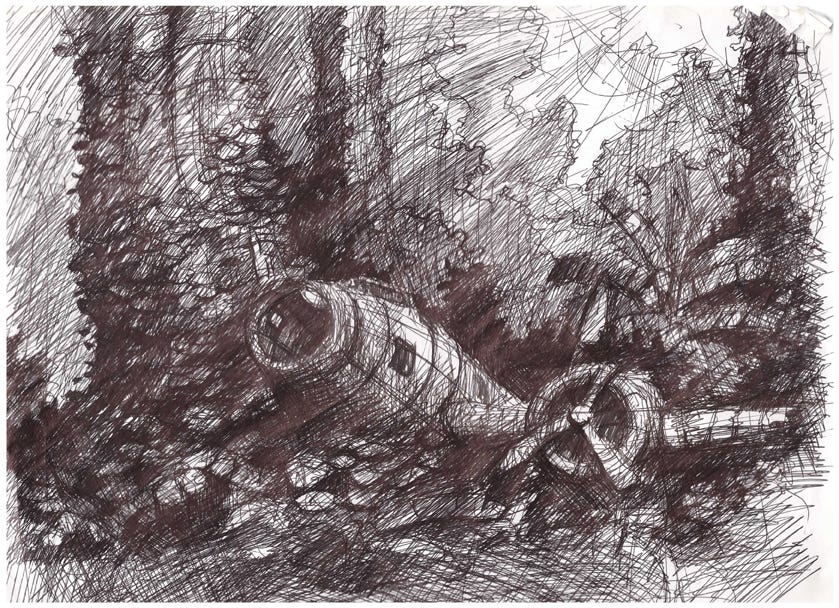
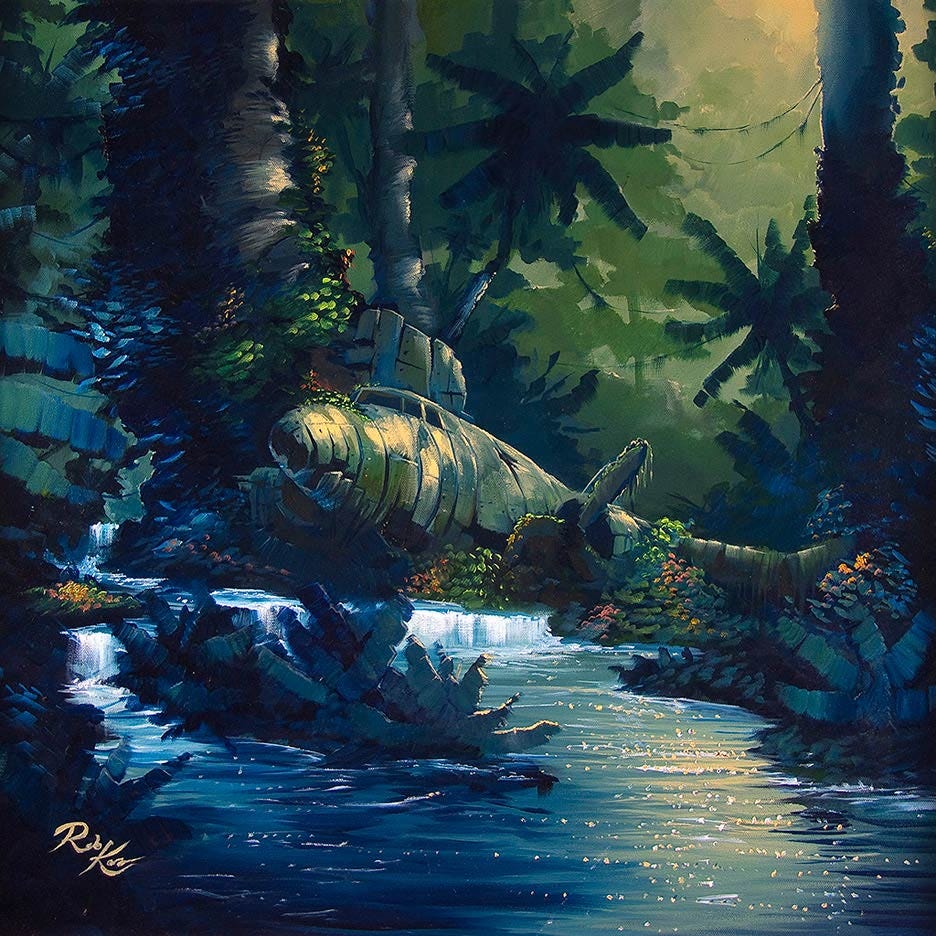
(left) A pen sketch by artist Rob Kaz which eventually became (right) an oil painting by artist Rob Kaz called Good Landing
Every hour that wasn’t spent at EA, I spent at the easel. With each painting, I sought to “up” the one before it with technique, lighting, composition, story.
When my time at EA came to a close for the 3rd year, I thought long and hard about my future. I asked myself if a future in studios was what I wanted? The answer was no. If I was honest with myself, I wanted to paint … full time.
And so I did.
I took a leap of faith. The hardest thing I ever did was tell EA no when they called again for the next cycle. It was scary as hell! Not going to lie. But it meant long hours and I knew that if I committed to EA, I wouldn’t have time to paint and build a body of works, which was essential to my longterm goal.
In the beginning, I painted lighthouses, shacks on the banks of rivers, manatees, airplanes. My subjects were all over the place. However, one thing remained consistent across all my works - a style resembling animation. My background in studio animation was without doubt showing through. Why not embrace that style? Who says animation can’t translate into fine art? Who says animation doesn’t equate to talent? Who says technique, lighting and composition can’t be strong in a painting that was meant to make the viewer smile? No one!
So, I began painting in a style that made me happy. Not a style that I thought would be popular or a style that would result in sales (although one can hope). I developed my style and perfected it and gave it everything I had.
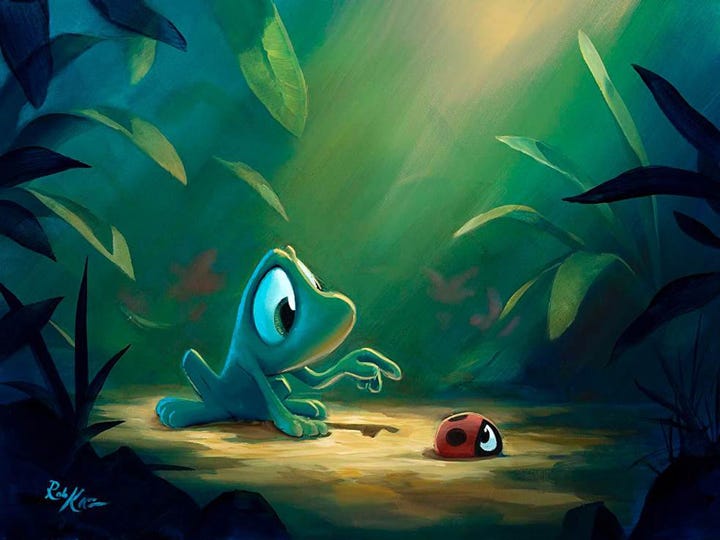
Beau the frog and Red the ladybug in Low Speed Chase by artist Rob Kaz
When I first painted Beau the frog with his big, animated eyes and human-like expressions, I feared what the art world would think. Was he too simple? Was he too cartoony? Would other artists consider my style too childish and see no talent?
I took my first two Beau paintings (Hey You and Hey Me) to an art festival on the streets of Ocala. The reception Beau received by festival visitors blew me away. People liked him! They asked questions. They wanted to know his story. They wanted to buy him! Both originals sold on the first day of the festival and people were asking for prints.
I had no idea what other artists thought of Beau, but I knew that buyers (and now collectors) found happiness in Beau. They smiled when they saw him. THAT was all I needed to know.
Finally, I’d found my style (deemed fine art animation) and I’d found my subject (story-telling through light and characters).
I focused on those two things with every single painting going forward. Beau became so popular that, even when he wasn’t the feature of a painting, I started hiding him in scenes, such as the collection Places I’d Rather Be.
ANSWER THE QUESTION ALREADY
Now, here comes the Disney part. I know the lead-up was long, but I feel it’s important to know I didn’t originally set out to be a Disney artist, not even an artist.
If you’re still hanging in here with me, let’s review some of the points I hope artful hopefuls have taken. 1) Though I have a college degree, it is not in art. Go to school. Definitely go to school. Art school or not, a degree WILL open doors and at least get you the interviews. 2) Find your own unique style in art. Copying the styles of popular artists will get you absolutely nowhere, but being unique will turn heads. 3) Just because you’ve defined your own style does not mean you should ignore technique or composition which are important to all styles and mediums.
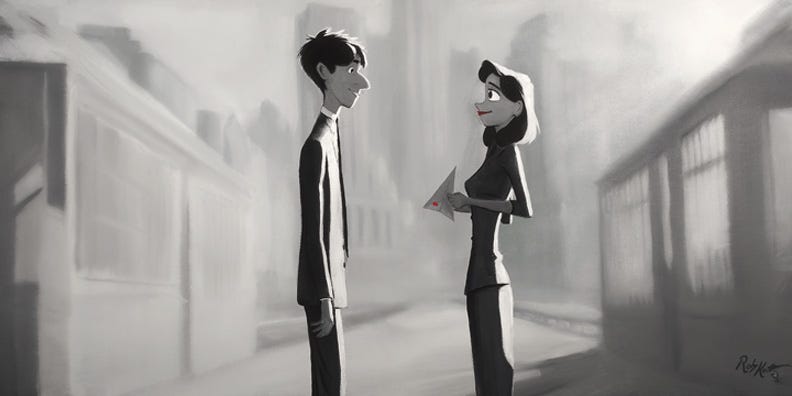
FIRST BE AN ARTIST
Before you try to be a Disney artist, just be an artist.
Again. Be an artist.
Before you do Disney, do you. Study. Learn. Develop your style. Paint. Don’t paint Disney. Paint you. Paint your own work, not someone else’s.
My opportunity with being a Disney licensed artist came via invitation. I received an invitation to paint a few trial Disney pieces because the powers-that-be liked the unique style and accomplishments that they saw in my existing body of work. My style was unlike anything they already had in their library of artists.
That invitation came because I had been doing my own thing and someone noticed. The invitation did not come because I had already been painting Disney on the side (which, by the way, profiting from this is of course a violation of trademark, copyright, you name it.). Don’t risk your future opportunity to proceed legally with a license. I see so many artists selling paintings of Mickey on Etsy or via Instagram. Seriously, “stealing” from Disney is not the way to communicate your commitment to their brand.
As a side note, I even found (thanks to a fan who spotted it and shared the link with me) an “artist” painting replicas of one of my Disney works and selling them as originals on Etsy. Aside from not painting my signature, the work was not altered in any way. Because this violated more than just my own copyright, the publishing company from Disney became involved and letters were issued. The artist apologized saying, “I’m just a smalltime artist trying to make money.” I’m not unsympathetic to trying to earn a living … I am, however, unsympathetic to plagiarism, theft and general dishonesty.
I’m a Disney fan. 100%, passholder-style fan. Prior to my invitation, don’t think I had not taken notice of Disney art hanging on the walls of my favorite galleries. Don’t think I didn’t long to be “part of their world.” I knew, however, it was more important for me to stay true to my own paintings. I’d worked hard to build my career thus far and I’d taken a lot of risks, but I didn’t dare take for granted or jeopardize the opportunities I had earned by trying to skirt the law. That didn’t make sense.
When the right people took notice of my existing art, decided I might be a good fit and decided to give me a shot, I jumped!

A Mad Tea Party by artist Rob Kaz, limited edition of 195
GET OUT THERE
So, your question though … how did the “right people” notice my art? Well, exposure. (I’m going to talk about what some folks think is “good exposure” in another Medium story later on that might get a little rant-like, and let me assure you free art is not “good exposure.”) Sure, a few hundred people a day might see my work on gallery walls here and there, but about the folks that don’t stumble into a gallery?
Website: I am fortunate to have a fairly brilliant wife who insisted early on that I have a fantastic website showcasing my artwork. She built me a modern site, which she updates regularly, that has a style reflective of my art. Most importantly, the site is informative (bio, list of gallery locations, where to buy art, links to social media, etc.) and shows all of my work with a search feature.
Social media: Can’t say enough. But I’m guessing that topic isn’t really necessary anyway. Everyone knows the drill.
Exhibits: Early in my career, I entered my works into a handful of curated art exhibits with prizes, which often included a small amount of press. I even managed to win a few ribbons and a best-in-show. The challenge with exhibits is that they often require a commitment of original art to be hung in their show for the length of the exhibit, which can be a month or more. For a working artist whose originals sale quickly with galleries that need to be constantly refreshed with new art, committing to an exhibit is not realistic.
Press: When you have real news to share, write a press release for local papers, community magazines, television stations, bloggers to whom your news might be relevant, etc.
Don’t Snub Your Nose At Opportunity: I was asked to allow editions of my paintings to be sold by a third party company who auctioned artwork on Royal Caribbean cruise ships. Sounds strange, right? I made a few bucks, not a ton. I got a free cruise here and there when they wanted the artist to appear on board. The exposure was unmistakable. My website hits went berserk with international visitors from all across the globe. Suddenly, I had collectors and fans who, though we didn’t share a common language, were connected via the love of art and a tiny green frog.
Basically, I’m saying that by ensuring my art gained audience, doors were opened. I met a publisher and those who represented the Disney art program found me via my publisher and extended an invitation.
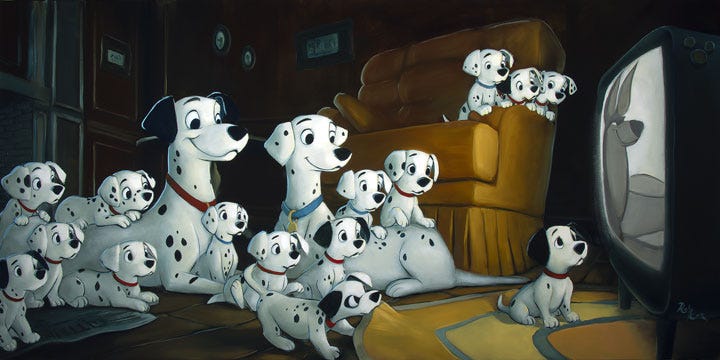
Family Time by artist Rob Kaz, limited edition of 95, sold out
MANAGING EXPECTATIONS
Even with a Disney license, know that there are rules. Securing a license doesn’t mean you can paint just any old thing you want. A license comes with standards to ensure the Disney brand is protected.
It makes sense. Disney has worked hard to establish an identity and personality for each character, attraction and film and of course they don’t want to see those brands reinvented. It wouldn’t make sense to paint Dumbo hanging out with Ariel. It wouldn’t make sense to paint Dori swimming through the waters of The Jungle Cruise. And it certainly wouldn’t be appropriate for Snow White to be kicked back with a glass of wine.
Each painting passes through a multitude of eyes before it is officially approved and considered for publication. Feedback is common, especially to ensure the characters are on model in terms of proportions, characteristics and personality. Again, it makes sense. These are the works of another artist and, as a painter, I respect that artist’s work. It’s not my prerogative to paint Belle wearing a purple ballgown just because “I’m an artist and I feel purple suits her soul.” No. Not going to happen.
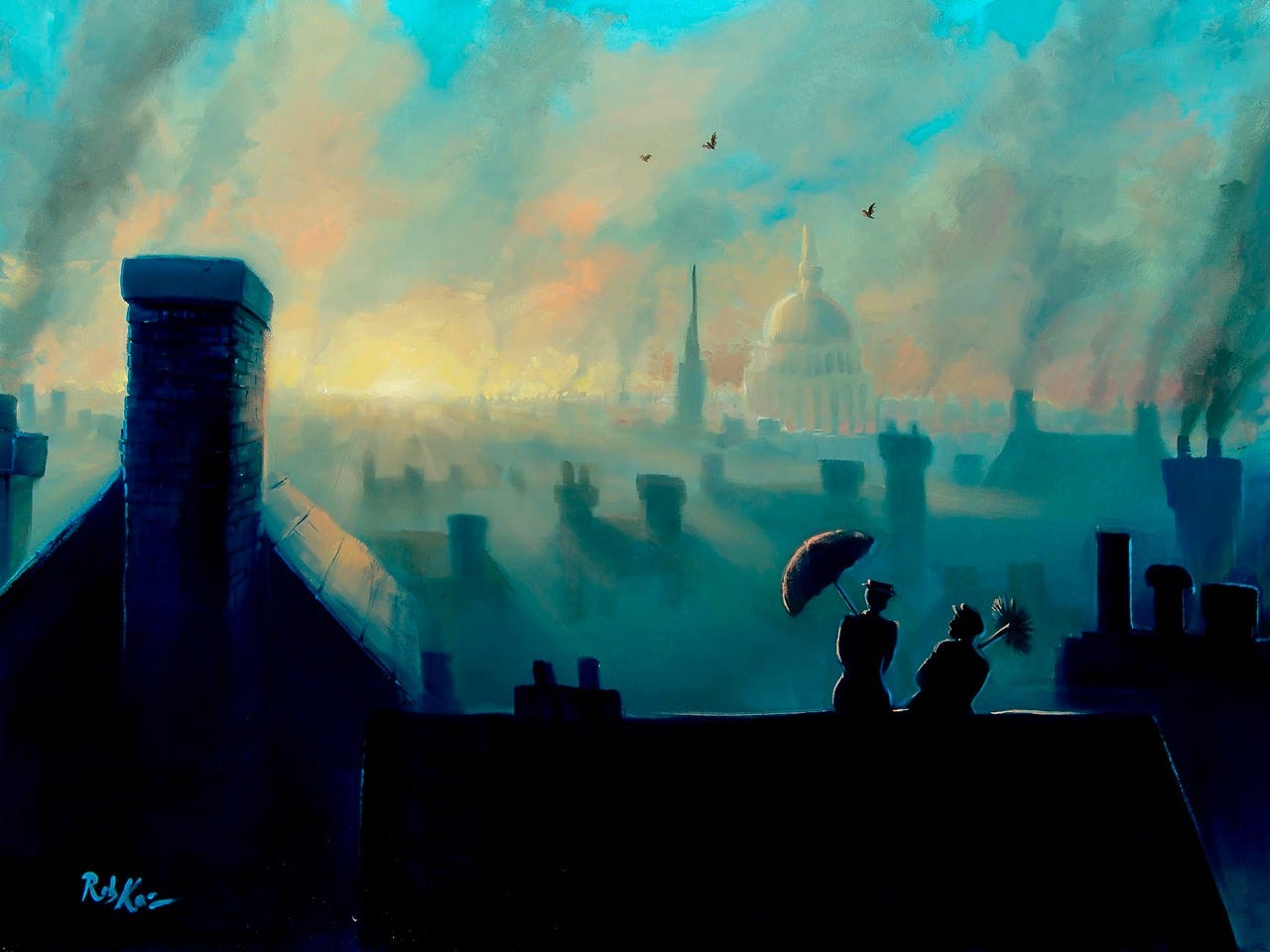
A View From The Chimneys by artist Rob Kaz, limited edition of 50
INTERPRETATIONS
As an artist (an artist first) with a Disney license (or any other license for that matter), it’s important to use your imagination. Painting a screenshot from a film is not super creative and might be considered boring. Often times, I will paint a popular scene from a different perspective or different “camera angle” so that the scene is sort of re-imagined while staying true to the original work.
Sometimes looking at concept art from a film will help spur your imagination. However, do so with caution. There is a ton of fan art on the internet — a lot of it really good. Be certain the concept art in your Google search results is in fact from the film’s history and not the work of another artist or even an art student completing a school assignment on concept art.
Even though I’m stressing the importance of interpreting the film for your canvas, it’s still important to remain true to story, characters, environment … interpretation doesn’t equate to change.
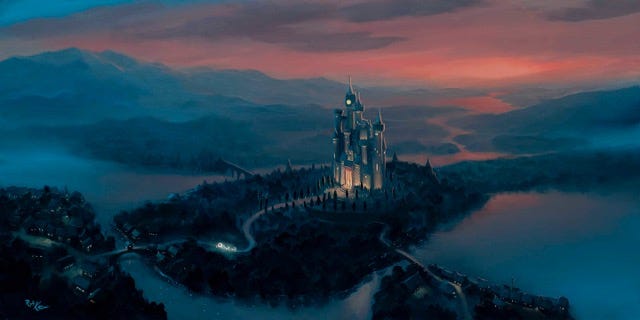
A Dream Coming True by artist Rob Kaz, limited edition of 95
HAPPILY EVER AFTER
So, how to become a Disney artist?
- First and foremost, be an artist.
- Develop your own unique style.
- Get your personal line of art into the world.
- Surround yourself with people who support your career and will provide sound advice.
- Think ahead and know that decisions you make now can and likely will affect your future.
- Be certain that a license is right for you (understand the details).
If you’ve done all of this (and hey, give it more than a few years to build your career), then you’re on the right track. If the circumstances are right and you, as an established artist are offered an opportunity to try your brush at painting Disney, then fantastic and congratulations on your accomplishments!
If the circumstances don’t present themselves, then even still I congratulate you on your accomplishments. Paint because you love to paint. Even if the career or financial returns don’t pan out the way you’d hoped, be proud that you’re living a life fulfilled with art and creativity.
My final piece of advice: ask other artists. I don’t know it all and this is just my own story and these are my own tips. Every artist has their own story. Take this for what it is — just my point of view. My tale is not a sanctioned or sponsored story. These tips didn’t come from Disney or any publisher. I’m simply answering a question that people ask me a lot. Best wishes — keep painting!

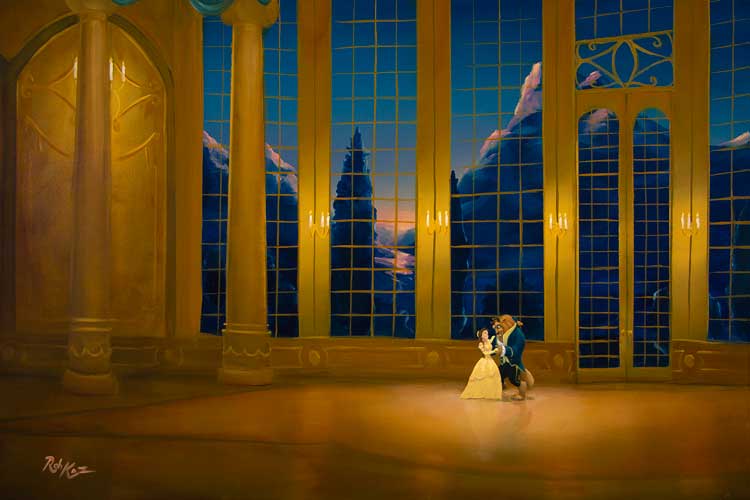
1 comment
Hi Rob
This is weird for me and I can say that I simply did not know you (at least your name). I have seen your work for Disney but never knew who did that work. Thank you for placing a name to your work and I will watch those credits in the future. To be an artist just coming out again after years of being dormant as I made a living from military to medicine. I am all over the place with my art from fish to flamenco at least I have found oils. It is a pleasure to me. I may never achieve fame or even be seen by many but I would love to do a Disney piece one day. Just for the study in light alone. I feel with your direction I can do so with out coping but noticing shading and color. I can say art is my thing, and if I never achieve fame I know that one day it will find me. It took me awhile to be able to express this for I feel that I am good and that is enough for me. I am so proud of you being able to make a living from your work please continue to share your thoughts for you got a fan, now.